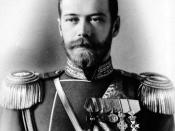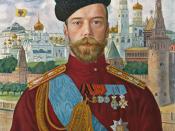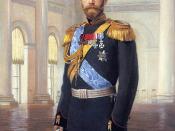Problems in Russia that contributed to the revolution in 1917 are numerous, but the chief reason is Russia's situation in the twentieth century. Russia, an autocracy with underrepresented citizens, already had the seeds sown for revolution. No one event caused the revolution, though factors such as Tsar Nicholas's decisions and the outbreak of World War II did contribute to the Tsar's overthrow, though to a lesser degree. Difficulties with the Russian form of government were the central grounds for the 1917 revolution. Russia's enormous size, difficult communications, and lack of unity between its different peoples had existed long before the 1900s. However, by 1900, its population had increased by fifty percent, increasing the competition of land between peasants. The workers' poor living conditions did not improve. In addition, Russia was ruled by an autocracy with a formidable secret police, the Okhrana, using violence to deal with any opposition to the government.
The Tsar knew very little about his people; he did not visit the factories or villages.
The Tsar's actions were also important steps leading to revolution in 1917. Life for the Russian people had ostensibly improved with the October Manifesto: there was a Duma - people's parliament, freedom of the press, and even the right to form political parties. However, the Okhrana were still as active as ever, "freedom" of the press still entailed censorship, and the Tsar could dissolve the Duma whenever he wished - elections were even in favor of the gentry and nobility. To make matters worse, the Tsar decided to go to the war front himself in 1915. He was now personally blamed for failures in the course of the war, and the Tsarina was left to run the government. Some mistrusted her because of her German background, and she would not work with...


